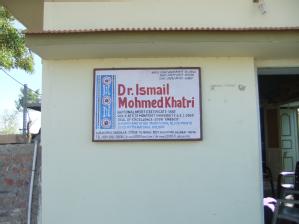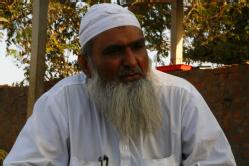Dr Ismail Mohammed Khatri
Interview Summary
Ismail Mohammed Khatri traces the origins of his community to a place called Santreja. During the reign of Rao Bharmal I in the sixteenth century, Jinda Jiva, one of the Khatri ancestors, was the first to settle in Dhamadka. The village proved to be ideal location for the washing and dyeing that was part of their craft. The artisans of the Khatri community traditionally engaged in a range of crafts including block printing, wax printing and bandhani making, all of which required a plentiful supply of water. Through each stage, water quality influences everything – from the shades of the colours themselves to the successful completion of a design or piece. The river adjacent to Dhamadka provided a regular and easily-accessible supply of good quality water in the dry and arid land of Kachchh.
Continuing the narrative of his community’s journey from Dhamadka to Ajrakhpur, Khatri mentioned that after 1991 the well and tank water level went down in his village. And, after the earthquake in 2001 when it became extremely difficult just to live let alone follow a profession in Dhamadka, a group of his community men approached him with a proposal to migrate. The artisans argued for immediate relocation before the water at the present site was either unusable or completely gone. Khatri, as the head of the community, turned down the request due to the difficulty inherent in leaving Dhamadka and the community’s ancestral houses, cemetery and schools. Yet, when Khatri was approached for a third time with the request to migrate he felt he could not refuse.
The Khatris therefore had to search for an appropriate place for the relocation. The long list of requirements included nearby healthcare facilities, a nearby railway station, a reliable water facility, good drainage, and many more factors, including the climate. After looking at all around Bhuj, Bhachau and Anjar, the resettlement was zeroed down to a place near Bhuj, later named as Ajrakhpur. This was quite a historic moment as in Kachchh very few new villages were built. Around 35 to 45 acres of land was arranged to be bought through a loan for residential, commercial and agricultural use. Two NGOs, namely Jamiat Ulmai Hind and VITI, rendered critical support in the making of Ajrakhpur. In sum, the newly established village fulfilled all the major requirements of the community. . Not all the families left Dhamadka, but almost all have purchased land at Ajrakhpur.
According to Khatri, ajrakhis one of the oldest crafts practiced in Kachchh. There are, of course, innumerable different types of designs and colours of this important type of textile. Women of the Aahir community wear black coloured chatanicloth and indigo red ommervaluamong others. The Harijans wear penuand bandhani padoand chatani; and the Muslim maldharis wear openu hydro pado limayai andpado. Because of these different consumption patterns, local demand was (and remains) critically important for artisans, and the Khatri community has historically held a central place satisfying the clothing needs of the people of Kachchh.
Though their profession ensured their livelihood, craft work had many risks. It regularly exposed them to toxic chemicals, making them prone to asthma and severe allergic reactions. Having realised the fatal effects of some chemical-based colours, many artisans moved back to using natural dye made from plants and herbs. Dr. Khatri spoke at length about two dye sources in particular: indigo and alizarin. He told us that although indigo is rather a semi-synthetic colour and is fermented naturally, the red colour from the alizarin tree (nephthytis afzelii) is purely a natural colour. The disadvantage of this tree is that it is the root that yields the colour, rather than the bark or branches, leading to regular felling by planters to sell on the root to merchants. The Khatris purchase the colour from these merchants.
Moving on to discuss the present situation of the local market, Khatri added that over the last thirty years, Kachchh has undergone remarkable transformation. The style of dress of the locals has changed, adversely affecting the business of the Khatris. Many of the locals no longer opt for hand-woven and printed cottons, choosing modern synthetic apparel instead.
 Khatri provided fascinating details from the pages of his past life. He attended two types of schools in his youth, one religious and the other one regular. The Madrasa classes were in the morning for two hours where lessons from the Quran were taught. While attending the regular school Ismail and his two brothers helped their parents in their profession. Normally after finishing homework or during the holidays they provided considerable help to their parents. In following the printing and dyeing for the Rabaris, Khatri’s father was prominently supported by his wife. Since the Khatri brothers had no sister, they also helped their mother in household work. Long before he became the owner of an ajrakh printing workshop of his own, exporting to the global market, Khatri himself learned his craft through hard work and through watching the work and following the instruction of his parents. Ismail Khatri and his two brothers Razzaque and Abdul Jabbar were all jointly pursuing the family business until 2007 when they separated. At present, his two sons are helping him in his well-expanded business. Khatri sees a good future for his business. He produces high-quality work to ensure good profits. His workshop encompasses a team of twelve workers engaged in producing lengths of ajrakh, much of which is made into designer stoles and saris. Khatri accepts order from India’s most renowned ethnic collection studio, Fab India. Initially, it was not easy to work with such a high profile enterprise as they demand a great deal, but once he understood their specific requirements the commercial tie became successful. In the words of Khatri, the success of the tie-up was the result of the combination of their mind, the artisans’ minds, the designer’s mind and good marketing.
Khatri provided fascinating details from the pages of his past life. He attended two types of schools in his youth, one religious and the other one regular. The Madrasa classes were in the morning for two hours where lessons from the Quran were taught. While attending the regular school Ismail and his two brothers helped their parents in their profession. Normally after finishing homework or during the holidays they provided considerable help to their parents. In following the printing and dyeing for the Rabaris, Khatri’s father was prominently supported by his wife. Since the Khatri brothers had no sister, they also helped their mother in household work. Long before he became the owner of an ajrakh printing workshop of his own, exporting to the global market, Khatri himself learned his craft through hard work and through watching the work and following the instruction of his parents. Ismail Khatri and his two brothers Razzaque and Abdul Jabbar were all jointly pursuing the family business until 2007 when they separated. At present, his two sons are helping him in his well-expanded business. Khatri sees a good future for his business. He produces high-quality work to ensure good profits. His workshop encompasses a team of twelve workers engaged in producing lengths of ajrakh, much of which is made into designer stoles and saris. Khatri accepts order from India’s most renowned ethnic collection studio, Fab India. Initially, it was not easy to work with such a high profile enterprise as they demand a great deal, but once he understood their specific requirements the commercial tie became successful. In the words of Khatri, the success of the tie-up was the result of the combination of their mind, the artisans’ minds, the designer’s mind and good marketing.
Following the 2001 earthquake in Kachchh, the MAIWA Foundation (Canada) which arranges fundraising activities to assist land purchases, offered the Khatri brothers financial help for their revival. After deliberating over the proposal, the Khatri brothers agreed to accept the loan but only after agreeing they would pay it back in full. Although MAIWA were happy not to receive anything – and had already profited from the sale of videos of the crafts - by 2007 Khatri brothers had returned 10,000 dollars. Khatri hopes to move his present workshop to another piece of land and he has accepted a loan of 1 million dollars from MAIWA, and invested a further million dollars of the family’s money to purchase the new plot. He plans to invest another 1.2 million to equip the workshop, bore a well and develop other facilities. His successful relationship with MAIWA and strong business acumen win him regular orders from the Canadian firm.
In addition to achieving a national merit certificate and a UNESCO seal of excellence, Khatri was also awarded an honorary doctorate degreefrom De Montfort University, Leicester, in 2003in recognition of his years of dedicated work in block-printing and his mentoring of several apprentices in the traditional craft. His profound knowledge about textile printing led to his involvement with historian Eiluned Edwards during her research on the Rabari community. Impressed with his mastery over the subject, Edwards subsequently recommended Khatri for an honorary degree. His award further encouraged him to continue to learn English and cultivate more foreign contacts.
Dr Ismail Mohammed Khatri, whose grandsons are the eleventh generation working in the family’s craft, stands as the pre-eminent custodian of the ajrakhtwo-sided block-printing of Kachchh.

Age: 54
Education: Class 7
Occupation: Ajrakh producer and workshop owner
Place of residence: Ajrakhpur (originally Dhamadka)
Date of Interview: 15/2/2012
